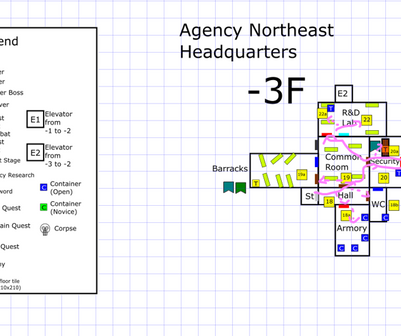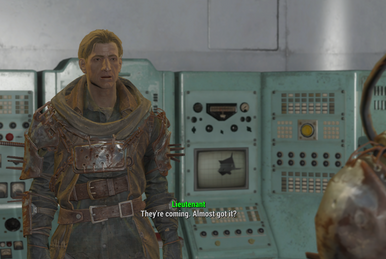The Ones Who Fear The Gods
A Fallout 4 Mod

Mod Zip File
Details
The Ones Who Fear The Gods is a Fallout 4 mod taking place mid-way through the base game's main story, right after meeting the Institute. The player is confronted with a member of another secret organization, called "The Agency", devoted to hunting down Psykers (humans with supernatural abilities) and preventing them from causing the end of the world. The player helps this agent rescue his apprentice from a gang of Psyker raiders, but finds out they are more sympathetic than they first appeared, and the player must ultimately choose in the end whether to end the Psykers or the Agency.
Mod Statistics:
-
Game: Fallout 4
-
Engine: Creation Kit
-
Platform: Windows
-
Team Size: 1
-
Development Time: 12 weeks (280 hours)
Level Design Overview
-
Designed, authored, and maintained Level Design Document (LDD).
-
Created new enemy type (Psyker) and new weapon (neural grenade) using Papyrus scripting and Fallout 4 Creation Kit tools.
-
Blocked out, built, populated, and decorated 1 interior cell and 1 worldspace with base Fallout 4 modular kit and integrated them into the Fallout 4 world and lore.
Environmental Design
Details
-
Created Small World settlement with emphasis on verticality, focused on the church as a landmark.
-
Town square modeled off of real-world town of Carlisle, Massachusetts.
-
Quest to reactivate town defenses gets player to explore these spaces and expands mission lore through terminal entries.
-
-
Created large interior space designed to feel lived in, attacked in recent history, and currently occupied by a new presence.
-
Entrance is integrated into the Commonwealth through a secret entrance near the Museum of Witchcraft, fitting into mission lore while bringing an area into sharper focus that didn't receive as much love in-game.
-
Problem Solving
Carlisle Layout
-
The initial plan for this mod was to model the settlement off of an area omitted from the Fallout 4 base game and DLC, the small town of Carlisle, Massachusetts, northwest of Concord.
-
Its triangular town square was unusual and seemed like a good setting for dynamic fights and quests.
-
However, making the extensive dungeon underneath the Museum of Witchcraft and an in-depth quest to put together in my first foray into Creation Kit meant it quickly became apparent by blockout that I had overscoped.
-
Not only that, but while the map was interesting from above, it came off as remarkably flat and uninteresting in-game. I knew I would have to cut something, but I wondered how much.
-
-
My solution was to focus on a single corner of the town, fence/wall it off (ostensibly against raider incursions), and create some verticality by molding a hill into the landscape, putting the church that was to be the site of the quest climax at the top.
-
This allowed me to hone the gameplay in a manageable playspace while letting the space still feel like part of a larger world.
-
The hill created a sense of drama, and when the town gets attacked at the end of the quest, it allowed for an additional element of difficulty by forcing the player to deal with enemies who have the high ground.
-
Gameplay Design
Details
-
Created Psyker enemy type by modifying Lorenzo Cabot AOE spell and integrating it into a raider's arsenal.
-
Balanced health, damage, and cooldown to emphasize challenge while still feeling fair.
-
Designed enemy spawns to take full advantage of the new AOE mechanic.
-
Gave Psykers a specific armor type to differentiate them from other FO4 enemies.
-
-
Created "neural grenade" weapon to give the allied faction (The Agency) a lore item that could counter Psykers.
-
Acts as an NPC-only stagger grenade that the player can use at close to medium range, knocking down organic enemies and preventing Psykers from using their powers.
-
Problem Solving
Psykers Overview
-
A primary pillar of "The Ones Who Fear the Gods" was setting out to flex my gameplay muscles. I wanted to see if I could add mechanics that would change how players thought about Fallout 4 combat without breaking the conceit of the world. And my answer to that was giving the player a new enemy to face, and a tool to face them with.
-
Psykers (basically Fallout's version of X-Men mutants) are enemies that have come up in select moments of the Fallout series, but the Bethesda Fallout games have never explored what they could do in a group, how devastating it could be to face gangs of people with effectively superpowers. As unique bosses, yes, but not as consistent enemy types the player could fight multiple times and in more challenging iterations.
The Cabot Solution
-
While Fallout 4's Creation Kit draws directly from Skyrim's Creation Kit, even keeping item classifications like "potions" and "spells" in-editor, it wasn't built with superpowers in mind.
-
Most enemy combat effects draw from science or mutation-based organic attacks, which didn't lend themselves to Psyker abilities in lore.
-
-
But there was one Psyker that they did include in the game: Lorenzo Cabot, an enigmatic old man who could fire telekinetic blasts in one of the game's more memorable side quests.
-
This power wasn't meant to be particularly balanced, showing up only if the player actively tried to fight him instead of gassing him in his prison cell.
-
Lorenzo had a ton of health, and this blast was meant to cripple the player and knock them over on every hit. It felt like what I was looking for, but I needed to figure out a way to make it manageable in a group.
-
Balancing the Blast
-
I learned all I could about spell effects to mess with the parameters of the telekinetic blast and made my own version, attaching it as a power for a new Psyker Raider class of enemy.
-
I reduced the blast's damage, its area of effect, its rate of fire, and crucially its limb damage (this was a particularly unbalanced effect for players in early iterations), allowing it to stun a player without taking them out of the fight.
-
I experimented on weapons to make my own grenade that did no damage but knocked enemies over, crucially preventing Psykers from using their powers.
-
This allowed larger battles with more Psykers to be more manageable, and let me adjust variables like health, weapon types, and armor to create different types of challenges from these enemies.
Incorporating Combat and Level Design
-
Even with these scripting adjustments, the combat still needed to be carefully designed to induce appropriate flow.
-
Psykers had to be introduced in an enclosed dungeon for story purposes, where they could be extremely dangerous, and where their AI decided it really liked to attack players through walls.
-
To solve this, I had to progressively enable more difficult groups of enemies in adjoining rooms based on where the player was in the base. This took a lot of iteration, and the end product could be janky at times, but in the end I got the gameplay and flow that I wanted.
Narrative Design
Details
-
Integrated quest into Fallout lore by using Psykers as an enemy type and referencing past Fallout characters like The Master and Professor Calvert.
-
Created narrative structure with meaningful choice by:
-
Starting the player from the perspective of one faction
-
Presenting sympathetic actions from the enemy faction in between fights
-
Painting neither side as wholly good nor wholly evil
-
Then giving the player the choice who to side with in the final confrontation.
-
-
Populated the world with additional environmental storytelling, from over 20 notes and terminal entries to thematically appropriate battle scars, skeletons, and graffiti, especially in the Agency Headquarters interior.
-
Researched Fallout lore to integrate factions into that world, with dialogue and terminal entries showing that The Agency is familiar with Psykers like The Master, Professor Calvert, Mama Murphy, and Lorenzo Cabot, as well as what they have been doing about them since the Great War.
Problem Solving
Conceiving The Agency
-
The quest structure and overall narrative of this quest offered some of the trickiest challenges I had to face as a designer, but it was also extremely rewarding.
-
One of the original Fallout series writers once remarked that Psykers offer a lot of narrative difficulties in that their mutations are so powerful that they could permanently warp the world and humanity extremely quickly if left unchecked.
-
I found that idea very interesting in the context of Fallout lore; if even the writers are wondering whether these superpowered beings should exist, surely there would be people in the Fallout universe asking themselves the same questions, and some who would do something about it.
-
Thus the idea of an agency devoted to exterminating Psykers was born, as was the choice that the player would ultimately have to make, between safeguarding the right of a superpowered group to exist, or choosing to destroy them to prevent the eventual destruction of humanity.
The Merits of Both Sides
-
To make the choice to side with one faction or the other meaningful, players need to be invested in both sides.
-
I knew the Agency would be unsympathetic to many, so I had to humanize them through a couple of key strategies.
-
I introduced the player to their perspective first through the main quest giver, Malcolm, an honorable man trying to protect his home. The player sees he cares about his apprentice and the townsfolk, who are largely helpful and friendly.
-
The player is then introduced to Psykers as a threat to the town, and see them through the threat they represent.
-
-
However, when the player first runs into Psykers in the flesh in the former HQ of the Agency, their leaders have some humanizing moments.
-
In dialogue sections the player can observe, the player can hear them acting reluctant and empathetic.
-
The player can also find out the boss had been experimented on by the Agency, and that her parents died trying to rescue her.
-
The Psykers might be brutal, but they're also defending their right to exist.
-
-
So when the player ultimately has their final confrontation with Malcolm and the Psyker Boss, they know both of these characters and their world views very well, and can sympathize with either.
-
Overall, the Psyker Boss ended up being more sympathetic to many players, but tuning the dialogue made it close to an even split.
Retrospective
What went well?
-
Lore, story, and gameplay design came together well, ended up feeling "very Fallout" to players.
-
Carlisle aesthetics ended up working out very well, with the layout and detail getting strong reception from players.
-
Agency environmental storytelling incorporated distinctive landmarks and a looping structure that didn't feel forced.
What went wrong?
-
Lighting needed more love in interior spaces. Initially focused on just getting the space well-lit rather than creating contrast.
-
Quest script complexity made the flow brittle, playtesters finding it easy to break.
-
Initial design for Small World was overscoped and flat due to initial reluctance to stray from Carlisle town square structure, meaning valuable dev time needed to be spent on an extensive redesign.
Even better if?
-
Scope down dialogue initially, then add choice and variations on later passes as development affords.
-
Incorporate lighting, not just layout, into early designs and iterations.
-
Visualize the space thoroughly early in development to spot potential layout issues.
-
Gameplay comes first; the real world can be an inspiration, but if it isn't fun or useful, it's not worth emphasizing in the game.



























